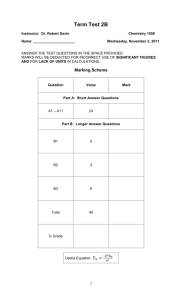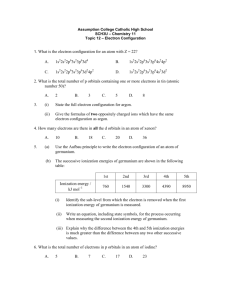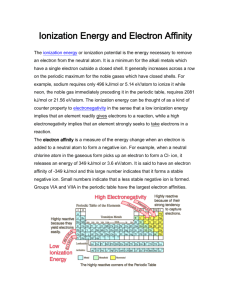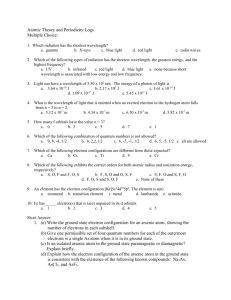Practice Test - mvhs
advertisement
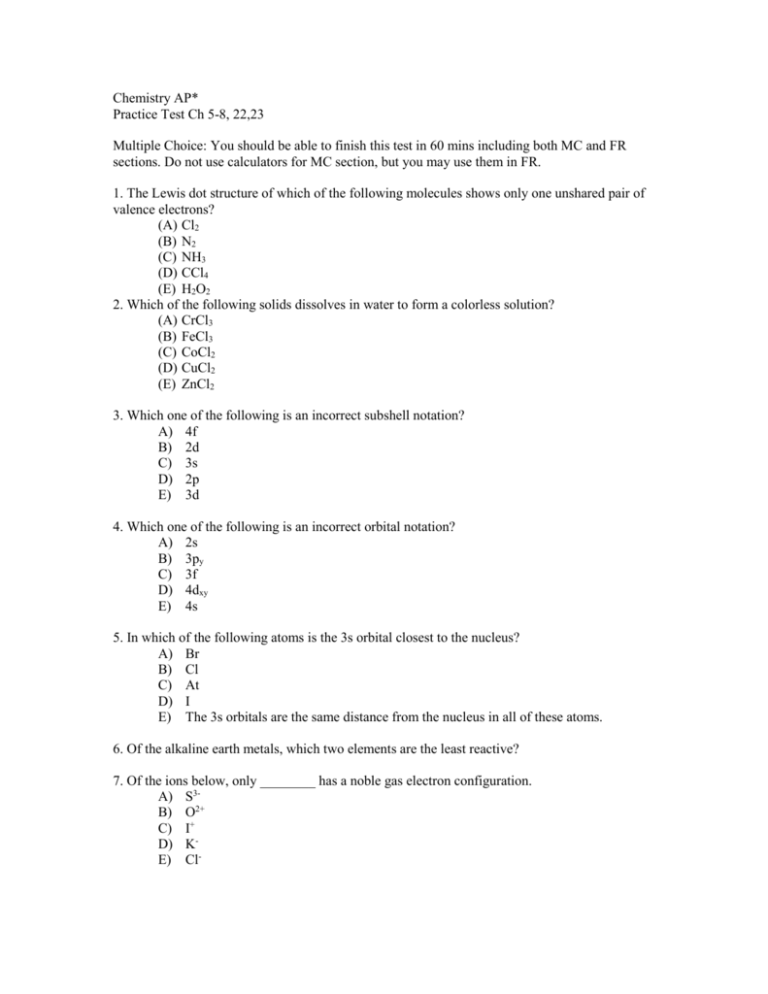
Chemistry AP* Practice Test Ch 5-8, 22,23 Multiple Choice: You should be able to finish this test in 60 mins including both MC and FR sections. Do not use calculators for MC section, but you may use them in FR. 1. The Lewis dot structure of which of the following molecules shows only one unshared pair of valence electrons? (A) Cl2 (B) N2 (C) NH3 (D) CCl4 (E) H2O2 2. Which of the following solids dissolves in water to form a colorless solution? (A) CrCl3 (B) FeCl3 (C) CoCl2 (D) CuCl2 (E) ZnCl2 3. Which one of the following is an incorrect subshell notation? A) 4f B) 2d C) 3s D) 2p E) 3d 4. Which one of the following is an incorrect orbital notation? A) 2s B) 3py C) 3f D) 4dxy E) 4s 5. In which of the following atoms is the 3s orbital closest to the nucleus? A) Br B) Cl C) At D) I E) The 3s orbitals are the same distance from the nucleus in all of these atoms. 6. Of the alkaline earth metals, which two elements are the least reactive? 7. Of the ions below, only ________ has a noble gas electron configuration. A) S3B) O2+ C) I+ D) KE) Cl- 8. The electron configuration of the phosphide (P3-) is ________. A)[Ne]3s2 B)[Ne]3s23p1 C)[Ne]3s23p3 D)[Ne]3p2 E)[Ne]3s23p6 9. The Lewis structure of PF3 shows that the central phosphorus atom has ________ nonbonding and ________ bonding electron pairs. A) 2,2 B) 1,3 C) 3,1 D) 2,3 E) 3,3 For the questions 10-15, consider the BEST Lewis structures of the following oxyions: I. NO2- II. NO3- III. SO32- IV. SO42- V. BrO310. The central atoms in ________ cannot expand octet. A) I only B) II only C) I and II D) II and III E) III and IV 11. The Lewis structure of ________ cannot be drawn without a non-zero formal charge on the central atom. A) I B) II C) III D) IV E) V 12. Lewis structures of which ions can be drawn with and without expanding the octet on the central atom? A) I and II B) III only C) IV only D) III and IV E) III, IV, and V 13. Lewis structures of which ions can be drawn with all formal charges being zero? A) all B) I and II C) II only D) III, IV, and V E) None 14. There can be four equivalent best resonance structures of ________. A) I B) II C) III D) IV E) V 15. In which of the ions do all X-O bonds (X indicates the central atom) have the same length? A) none B) all C) I and II D) III and V E) III, IV, and V Free Response: 1. The values of the first three ionization energies (I1, I2, I3) for magnesium and argon are as follows: I1 I2 I3 (kJ/mol) Mg 735 1443 7730 (a) (b) (c) (d) Ar 1525 2665 3945 Give the electronic configurations of Mg and Ar. In terms of these configurations, explain why the values of the first and second ionization energies of Mg are significantly lower than the values for Ar, whereas the third ionization energy of Mg is much larger than the third ionization energy of Ar. If a sample of Ar in one container and a sample of Mg in another container are each heated and chlorine is passed into each container, what compounds, if any, will be formed? Explain in terms of the electronic configurations given in part (a). Element Q has the following first three ionization energies: I1 I2 I3 (kJ/mol) Q 496 4568 6920 What is the formula for the most likely compound of element Q with chlorine? Explain the choice of formula on the basis of the ionization energies. 2. CF4 XeF4 ClF3 (a) Draw a Lewis electron–dot structure for each of the molecules above and identify the shape of each. (b) Use the valence shell electron–pair repulsion (VSEPR) model to explain the geometry of each of these molecules. 3. Average Bond Dissociation Energies at 298 K _____________________________________________________ Bond Energy, kJ mol–1 C–H 414 C–C 347 C–Cl 377 Cl–Cl 243 H–Cl 431 The tables above contain information for determining thermodynamic properties of the reaction below. C2H5Cl(g) + Cl2(g C2H4Cl2(g) + HCl(g) Calculate the ∆H˚ for the reaction above, using the table of average bond dissociation energies. Answers to Practice Test: Multiple Choice Section: 1. c 2. e 3. b 4. c 5. c 6. Be, Mg 7. e 8. e 9. b 10. c 11. b 12. e 13. e 14. d 15. b Free Response: 1. Answer: (a) Mg: 1s2 2s22p6 3s1 Ar: 1s2 2s22p6 3s23p6 (b) Valence electrons for Mg and Ar are in the same principal energy level, but Ar atom is smaller and has a greater nuclear charge. Thus, ionization energies for Mg are less than those for Ar. Removal of third electron from Mg atom is from n = 2 level and electrons in this level experience strong nuclear attraction. (c) Only MgCl2 forms. Mg atoms readily lose 2 valence electrons each. Ionization energy for third electron very high. Electron affinity for Ar is low, and ionization energies for Ar atoms are high. (d) Formula is QCl. Very high second ionization energy indicates that there is only one valence electron. F : : : : : : Xe F F square planar : : : : : : : : : : : : : : : : : : F : : F: : F : C: F : :F: tetrahedral : : : : : : : : : 2. Answer: (a) :F: Cl: F: : F: T-shaped (b) CF4 - 4 bonding pairs around C at corners of regular tetrahedron to minimize repulsion (maximize bond angles). XeF4 - 4 bonding pairs and 2 lone pairs give octahedral shape with lone pairs on opposite sides of Xe atom ClF3 - 3 bonding pairs and 2 lone pairs give trigonal bipyramid with one pairs in equatorial positions 120˚ apart. 3. Answer: ∆H = energy of bonds broken – energy of bonds formed C2H5Cl + Cl2 ⁄ C2H4Cl2 + HCl ∆H = (2794 + 243) – (2757 + 431) kJ = –151 kJ OR CH + Cl– –Cl + HCl (representing the changes) ∆H = (414) + 243) – (377 + 431) = –151 kJ



